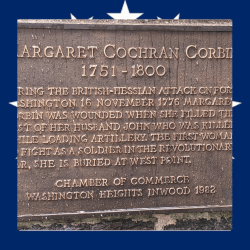
“Molly Pitcher” is a legend heard by many Americans growing up, and often used as a blanket term to describe the elusive women who fought in battle during the Revolutionary War. A striking fact, however, is that this fictional identity can likely be attributed to the works of a real woman! Margret Cochran Corbin, born in 1751 in Franklin County Pennsylvania, is one of the women who inspired this legend, and her heroic actions must not be forgotten.
Unlike other notable women during this time, Margret was orphaned and did not come from a family with significant financial savings. She had limited resources and found herself living in poverty for the greater part of her childhood. Her uncle eventually adopted her and her brother, and the siblings began living together in a Philadelphia home.
At the age of 21, Margret married a young man named John Corbin. As murmurs of a revolution or revolt against the British began to grow, her husband enlisted in the Continental Army and proclaimed his desire to serve under Washington and the other leaders of the Revolution. Like many women of modest means, Margret had no choice but to follow her husband to the battlefield, working as a camp hand and nurse for the soldiers that were living there.
However, working in these military camps was dangerous and often life-threatening. During the war, they were hotspots for attacks, and women responsible for dressing soldiers’ wounds could easily get caught up in lines of cannons and other fire.
One day, whilst spending time with her husband in the camps, the British attacked fiercely and without warning. To save her own life and protect her beloved John, she lept into action and, dressed in men’s clothes, began assisting her husband with cannon fire. He ended up being shot down and killed in battle, after which she took over and began controlling fire herself. Unfortunately, the British came away from that battle with a victory, and Margret ended up serving a brief stint as a prisoner of war before her release to attend to battle injuries.
The life that followed her bravery was not easy, as Margret ended up living with modest means and no significant income. Unfortunately and despite all of the work she undertook to protect America, women during the Revolution depended on the income of their husbands, and with John’s passing and her older age Margret was left destitute; she was never able to financially recover from the death of her husband. Margret fruitlessly tried to marry again but the gentleman passed away just one year after the ceremony.
She passed away in the year 1800, right before her fiftieth birthday. Her bravery might not have been recognized within her lifetime, but more than a century later in 1920, her remains were moved to West Point and she was buried with full military honors. Today, she is also one of the few women attributed to the legend of Molly Pitcher, a brave female soldier who gave her heart and soul to fight for the Revolutionaries, and her memory lives on.
